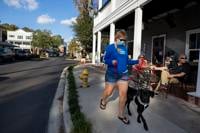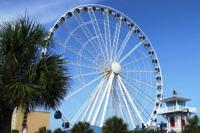MYRTLE BEACH — A group of private investors plan to step up to help the city develop downtown Myrtle Beach, with hopes to make the area more pedestrian friendly, better connecting the oceanfront to downtown neighborhoods and adding more homes.
Myrtle Beach City Council heard about efforts of One Grand Strand, an “association of business and community leaders dedicated to promoting the growth and diversification of the Myrtle Beach economy,” during Tuesday’s special meeting.
Architects and designers of James Lima Planning and Development and Plan and Process presented council with both long- and short-term plans for areas of Broadway Street, the boardwalk and neighborhoods like Withers Swash. Plans also include a Coastal Carolina University facility and theater around the Superblock.
Robert Lane, architect and urban designer, said the plan’s timeline isn’t necessarily a long one, with some being long term, while other plans are immediate.
“The reason that I like this plan is because...there are about 100 relatively small, short-term things that can happen to make this come to life,” Lane said.
The plans for One Grand Strand come a little more than a year after the Economic Development Corporation dissolved. OGS plans are solely targeted to the downtown portion of the city and partners hope to revitalize, develop and attract visitors, students and locals for work and leisure.
“Most of the pieces of what we are describing are already there,” said James Lima, president of James Lima Planning and Development. “It’s about expanding the vision to really tell a bigger story that is impacting and compelling.”
Lima’s firm is based out of New York City. A graduate of Columbia College, Lima has taught courses on economic development at some of the nation’s top universities like Yale, Columbia and Princeton.
The plan could come to fruition if council votes in favor of adopting OGS into its downtown master plan. The item could be on the agenda next meeting, set for Dec. 8. Despite a coming holiday season, City Manager John Pedersen believes the plans are ready to move forward. Council instructed him to begin working with businesses to implement the plan.
Council members Mike Lowder and Philip Render were absent Tuesday.
Challenges of downtown
Nearly 25 percent of property downtown is vacant or underutilized, Lima said.
“It’s an opportunity for redevelopment,” he said.
Lima presented five challenges that the city faces that OGS hopes to address in its plans. Some of the main challenges are a lack of economic diversity and the poverty rate.
Downtown Myrtle Beach lost nearly 42 percent of its employment between 2002 and 2017, Lima said, adding the pandemic has highlighted the vulnerability of a “tourism-reliant” economy.
“Hospitality has served Myrtle Beach well, but we also know from the current pandemic that hospitality jobs...have been severely affected,” Lima said.
The presentation stated the average downtown has 13 residents per acre, while Myrtle Beach has 4.5. The city’s downtown has about 3,300 residents within 1,438 households.
Additional challenges Lima highlighted include public and pedestrian safety, attractiveness and vibrancy, and lack of place management.
OGS plans to address those issues with its Blue-Green Network plan to link the area’s natural assets and wetlands, which could connect downtown to Withers Swash and the Intracoastal Waterway by bike path, making it more pedestrian friendly.
“I love the connectivity of various areas to each other,” Myrtle Beach Mayor Brenda Bethune told the Post and Courier. “This creates community and makes our downtown a great place for our residents, which in turn makes it a great place for visitors as well."
Bethune said the city is fortunate to have One Grand Strand working beside it to achieve success for its downtown master plan.
“They understand the necessity of having a thriving downtown as we bounce forward to become a resilient city,” she said.
How will OGS work?
One Grand Strand, a nonprofit, hired James Lima Planning and Development and Plan & Process, two New York City firms, to develop a vision for Myrtle Beach’s Opportunity Zones, according to the city. The organization is a private and public partnership made up of a board and staff. Its CEO is Michael Clayton, a retired partner of an international law firm. Clayton also holds an honorary doctorate from Coastal Carolina University, according to his LinkedIn page.
Over the past year, the team created a strategy to “attract greater developer interest and investment, support and address the needs of small businesses, create quality job opportunities, and increase the amount of housing options available downtown.” OGS studied the area within 20th Avenue North, 3rd Avenue North and Canal Street, King Street, Washington Street and Grissom Parkway, and the ocean.
According to the city, the initiative builds on the its efforts to date, including plans for the Arts and Innovation District and the establishment of a Coastal Carolina University presence on Chester Street.
If city council accepts the partnership, the projects and budgets would be developed in the future, in concert with the city’s existing master plans and other projects, said Mark Kruea, Myrtle Beach spokesperson. Council could take action during the Dec. 8 meeting, according to the city’s agenda.
The city is exploring the use of TIF and MID, as well as supplemental funds like public or philanthropic contributions, corporate sponsorships and earned income through program services.
One Grand Strand is the latest in Myrtle Beach’s ongoing effort to improve the downtown area. Lima thanked the city’s leadership for creating these plans. In fact, the funding strategies are similar to past improvement plans within the city.
Just last month the city approved plans to finalize the expansion of the TIF district for the Oceanfront development plan. This connects the oceanfront plan to the Arts and Innovation district, as well as bringing in a potential $325 million in revenue for redevelopment plans over the coming decades.
The city often uses TIFs to finance projects, as the tax strategy was used to fund the Market Common and Broadway at the Beach. This strategy aims to make development pay for itself by earmarking the increased tax revenue generated by the redevelopment efforts.
The second way the city is looking to fund its plans is through a Municipal Improvement District. Creating this district requires by-in from the business community within the district, but could lead to an expansion of city-owned property like a park, roadways or even a canal (although a canal isn’t being proposed).
A MID is normally used when an area is at risk of losing property value. The strategy hopes to improve the desirability of the area with the help of existing businesses.
Once the city gets consent from a majority of businesses to create the MID, a special tax assessment will be applied to these businesses to help fund and bond projects — the more successful the redevelopment effort, the more money that will be generated.
“We support all this,” said Michelle Kerscher with the Gay Dolphin, a business that would have to agree to the MID. “But there are questions we have because it was a lot of information.”
"plan" - Google News
December 01, 2020 at 11:16PM
https://ift.tt/2VBbIEJ
One Grand Strand: Myrtle Beach council hears plans for a new downtown development plan - Charleston Post Courier
"plan" - Google News
https://ift.tt/2un5VYV
Shoes Man Tutorial
Pos News Update
Meme Update
Korean Entertainment News
Japan News Update
Bagikan Berita Ini
















0 Response to "One Grand Strand: Myrtle Beach council hears plans for a new downtown development plan - Charleston Post Courier"
Post a Comment